Design strategy of advanced generation breeding population of Pinus tabuliformis based on genetic variation and inbreeding level
IF 4.4
1区 农林科学
Q1 FORESTRY
引用次数: 0
Abstract
The level of genetic variation within a breeding population affects the effectiveness of selection strategies for genetic improvement. The relationship between genetic variation level within Pinus tabuliformis breeding populations and selection strategies or selection effectiveness is not fully investigated. Here, we compared the selection effectiveness of combined and individual direct selection strategies using half- and full-sib families produced from advanced-generation P. tabuliformis seed orchard as our test populations. Our results revealed that, within half-sib families, average diameter at breast height (DBH), tree height, and volume growth of superior individuals selected by the direct selection strategy were higher by 7.72%, 18.56%, and 31.01%, respectively, than those selected by the combined selection strategy. Furthermore, significant differences (P < 0.01) were observed between the two strategies in terms of the expected genetic gains for average tree height and volume. In contrast, within full-sib families, the differences in tree average DBH, height, and volume between the two selection strategies were relatively minor with increase of 0.17%, 2.73%, and 2.21%, respectively, and no significant differences were found in the average expected genetic gains for the studied traits. Half-sib families exhibited greater phenotypic and genetic variation, resulting in improved selection efficiency with the direct selection strategy but also introduced a level of inbreeding risk. Based on genetic distance estimates using molecular markers, our comparative seed orchard design analysis showed that the Improved Adaptive Genetic Programming Algorithm (IAPGA) reduced the average inbreeding coefficient by 14.36% and 14.73% compared to sequential and random designs, respectively. In conclusion, the combination of the direct selection strategy with IAPGA seed orchard design aimed at minimizing inbreeding offered an efficient approach for establishing advanced-generation P. tabuliformis seed orchards.
基于遗传变异和近交水平的油松高代繁殖群体设计策略
育种群体内的遗传变异水平影响遗传改良选择策略的有效性。油松育种群体遗传变异水平与选择策略或选择效果之间的关系尚未得到充分研究。本研究以来自油油树种子园的半同胞和全同胞家庭作为试验群体,比较了组合和个体直接选择策略的选择效果。结果表明,在半同胞家系中,采用直接选择策略的优势个体胸径、树高和体长分别比采用联合选择策略的优势个体高7.72%、18.56%和31.01%。此外,显著差异(P <;在平均树高和平均树积的预期遗传增益方面,两种策略的差异均为0.01)。在全同胞家系中,两种选择策略在树平均胸径、树高和树体积上的差异相对较小,分别增加了0.17%、2.73%和2.21%,所研究性状的平均预期遗传增益无显著差异。半同胞家庭表现出更大的表型和遗传变异,从而提高了直接选择策略的选择效率,但也引入了一定程度的近交风险。基于分子标记的遗传距离估算结果表明,改进的自适应遗传规划算法(IAPGA)与随机设计相比,平均近交系系数分别降低了14.36%和14.73%。综上所述,将直接选择策略与以减少近亲繁殖为目标的IAPGA种子园设计相结合,是建立先进一代油油树种子园的有效途径。
本文章由计算机程序翻译,如有差异,请以英文原文为准。
求助全文
约1分钟内获得全文
求助全文
来源期刊

Forest Ecosystems
Environmental Science-Nature and Landscape Conservation
CiteScore
7.10
自引率
4.90%
发文量
1115
审稿时长
22 days
期刊介绍:
Forest Ecosystems is an open access, peer-reviewed journal publishing scientific communications from any discipline that can provide interesting contributions about the structure and dynamics of "natural" and "domesticated" forest ecosystems, and their services to people. The journal welcomes innovative science as well as application oriented work that will enhance understanding of woody plant communities. Very specific studies are welcome if they are part of a thematic series that provides some holistic perspective that is of general interest.
 求助内容:
求助内容: 应助结果提醒方式:
应助结果提醒方式:


